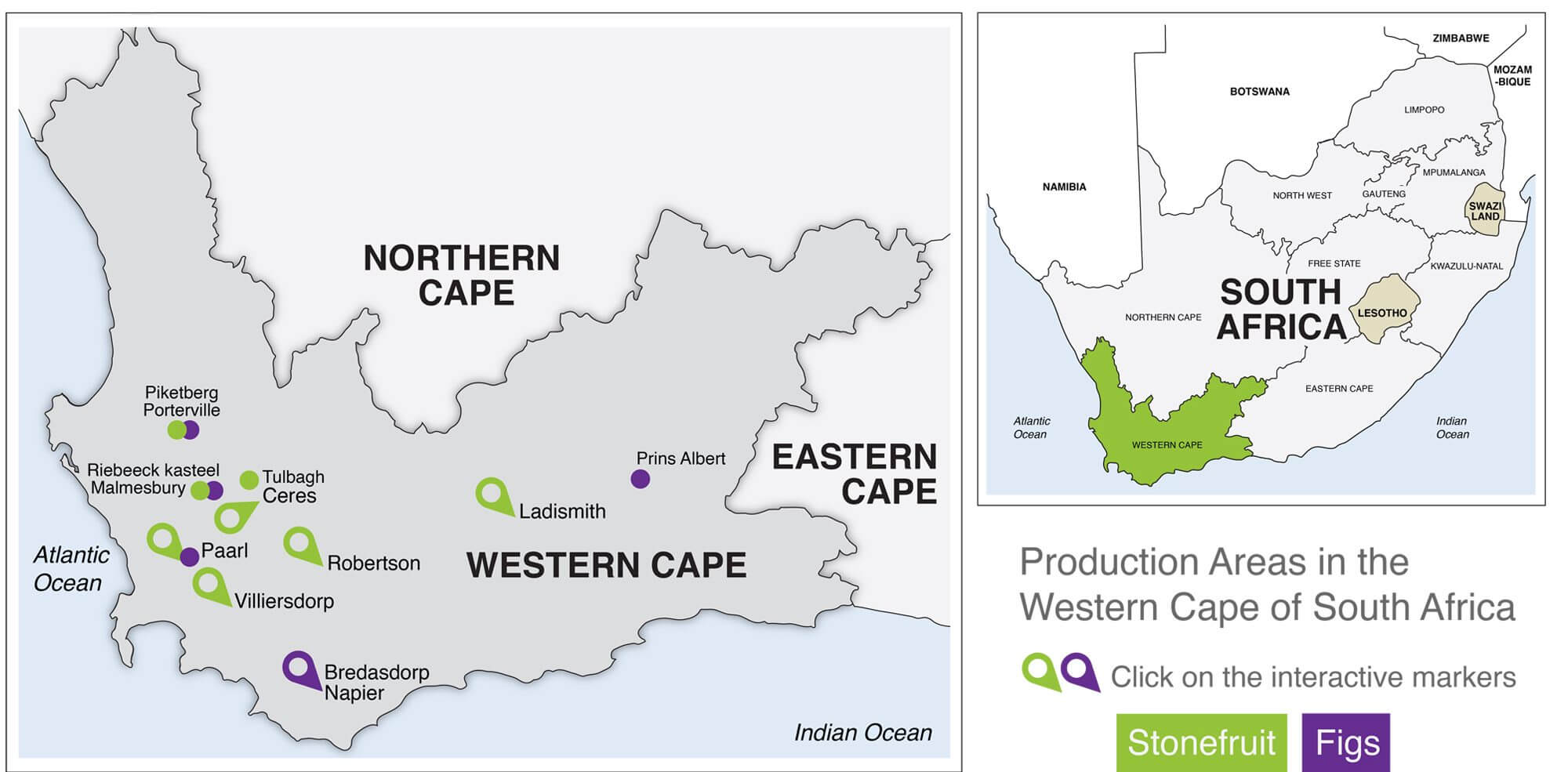Production areas: Interactive Map
MID – MEDIUM CHILL AREA: (250 – 500 Cold Units) | Production: November to mid-March
WESTERN CAPE
Ladismith
The Hoeko valley is situated in the foothills of the Swartberg mountains, 550m above sea level. Despite the fact that the average annual rainfall is only around 300mm, the water rich ravines supply enough water throughout the year to support a sustainable fruit industry in the valley below. The low rainfall, hot summers and extremely cold winters of this area provide the ideal climate for the cultivation of good quality Stone Fruit, with specific reference to Apricots and Plums. More …
Paarl
Paarl is situated 120m above sea level and was named after the prominent geological feature, Pearl Mountain or “Paarl Rock”. This area has an annual winter rainfall of 650mm with daily temperatures averaging between 16°C in July to 28°C in February. With its fertile soils and Mediterranean-like climate, this regions provides perfect conditions for the production of Nectarines, Peaches and Plums. More …
Villiersdorp
The orchards are planted in a narrow valley, 320m above sea level surrounded by the Rivier-sonder-end and the Stettyn mountains, called the Bossieveld (Shrub veld). The surrounding mountains play a central part in creating a unique micro climate. Due to a low annual rainfall of between 250 and 450mm and high daily temperatures this area has a low fungal pressure and produces fruit with high sugars and above average fruit size. More …
Robertson
The Breede River Valley is known for being the largest fruit and wine producing valley in the Western Cape and was formed by its namesake, the Breede River. The Breede River Valley is relatively broad and flat for a Western Cape valley, averaging at a floor height of 80 – 250m above sea level. It is completely encircled by high mountains of the Cape Fold Belt ranging in height from 1 500m to upward of 2000m’s. This area is climatically diverse, however it completely falls within a Mediterranean climate with most precipitation falling in winter (May through September); the annual rainfall for Robertson can vary between 175 – 300 mm. Summers can be very hot, due to the Du Toitskloof and Riviersonderend Mountains blocking cooling oceanic breezes from reaching the valley. During winter however, the valley is often colder than other seaward regions and snow is a regular occurrence on the surrounding mountains. This unique climate is ideal for the production of Stone Fruit, with specific reference to Plums. More …
Bredasdorp/Napier
Tucked away at the bottom of the Soetmuisberg and surrounded by flowering fields of bright canola, wheat and barley lies the small town, Napier. The town was founded in 1838 and is situated 109m above sea level in the Cape Agulhas region between Caledon and Bredasdorp. The area has an average annual rainfall of 483mm and its proximity to the ocean means the cool maritime breeze moderates the variation of temperature. More …
LATE – HIGH CHILL AREA: (500 – 800 Cold Units) | Production: November to April
WESTERN CAPE
Ceres, Prince Alfred’s Hamlet
Nestled 600m above sea level, between the Skurweberg and Matroosberg mountains, this fertile valley, named after the Goddess of Fertility has an ideal micro climate for the production of medium to late Nectarines, Peaches and Plums. The extremely cold winters, a moderate spring, warm summers and relatively wind free area allows the production of fruit with an exceptional clean appearance, good fruit size, sugars and coloration. With a limited average annual rainfall of only 350 – 550mm, this area has access to very good quality water sources, namely the Koekedouw and Warm Bokkeveld water schemes. More …



